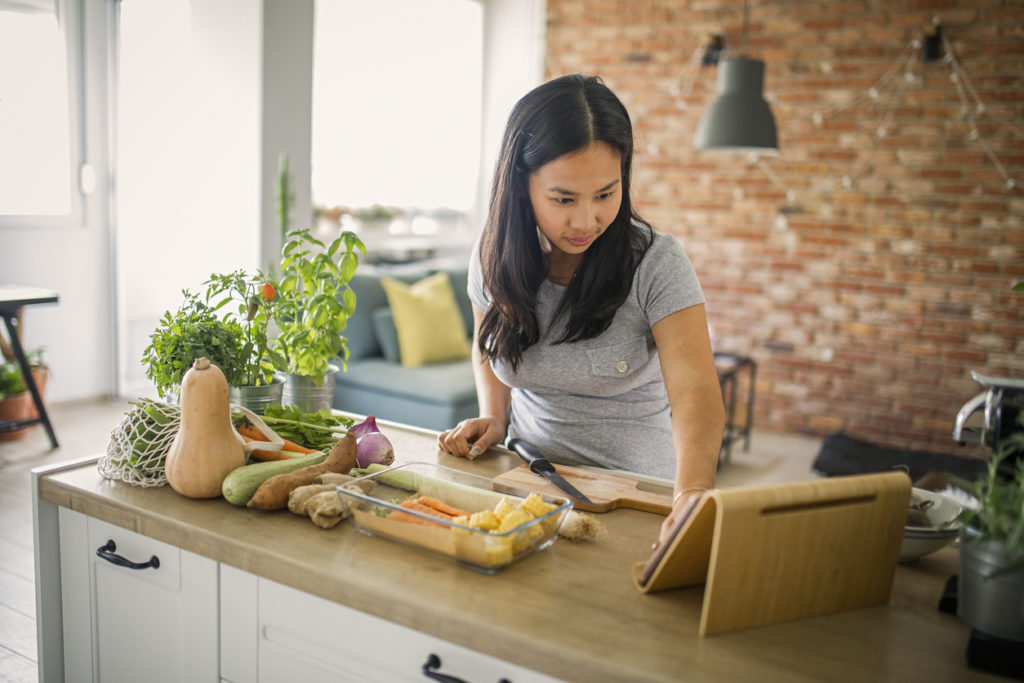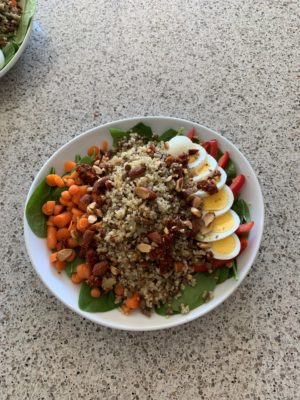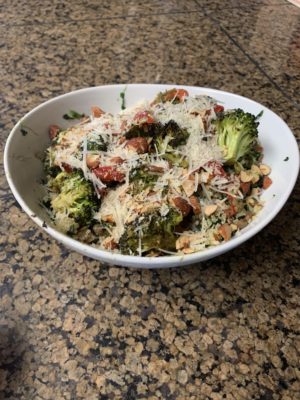Four Of The Top Nutrients Women Need To Know

by Rebecca Dattola, MS, Registered & Licensed Dietitian, Sigma Alpha (West Virginia U)

Proper nutrition can help set the foundation for a healthy lifestyle. Getting all the nutrients you need in your diet can help you feel strong and energized. We typically divide nutrients into two categories, macronutrients and micronutrients. Proteins, fats, and carbohydrates are considered macronutrients and they provide our bodies with energy. Micronutrients include the many vitamins and minerals. These don’t provide us with energy but support our bodies in other ways. Foods typically provide multiple nutrients, so eating a variety of foods each day will help you meet your needs. While an overall balanced diet is important, there are some nutrients that women should keep in mind.
Let’s focus on four nutrients today: iron, folate, calcium, and vitamin D. Everyone needs these nutrients, but for women they are especially important. The amount we need may change throughout our lifetime and with specific health conditions. For more information on individual vitamins and minerals, visit the website for the Office of Dietary Supplements (https://ods.od.nih.gov/factsheets/list-all/).
Iron
Iron is a mineral used to make proteins the body uses to transport oxygen. Most women need more iron then men due to menstruation, about 18 grams a day. Iron can be found in a variety of foods including meats, poultry, seafood as well as beans, legumes, and some leafy green vegetables. Animal sources are more easily absorbed then plant foods but eating iron rich foods with vitamin C can help with absorption.
Folate
Many plant foods, like spinach, asparagus, and black-eyed peas contain the B-vitamin, folate. A synthetic form, folic acid, is also added to some foods. Folate is integral for making genetic material like DNA and for helping cells divide. Most women need at least 400 mcg per day of dietary folate equivalents, but this increases during pregnancy and breast feeding. It is crucial that women of childbearing age meet their folate needs before and during pregnancy to help prevent birth defects.
Calcium
You may know that calcium is found in dairy products, but it can also be found in some leafy green vegetables and is added to some fortified foods. Calcium is needed to maintain strong bones and contributes to the use of hormones and enzymes throughout the body. Most women need 1000 mg/day. As women get older, they need more calcium because their absorption of the mineral decreases and their rate of bone loss increases.
Vitamin D
Vitamin D works with calcium to maintain strong bones as well as help the muscular, neurological, and immune systems work their best. Most women need 15 mcg or 600 IU units per day. We get the majority of our vitamin D from fortified foods since it is only found naturally in a few foods, like fatty fish and egg yolks. Our bodies can also make vitamin D when exposed to the sun, but appropriate sun protection will limit this process.
Most women can meet their needs of vitamins and minerals by eating a balanced diet with a focus on foods like whole grains, fruits, vegetables, and lean proteins. You do not usually need to eat one, specific food to get any of the nutrients your body requires. Most foods contain multiple nutrients and pairing some foods together will increase the absorption of the nutrients. If you are concerned about a specific nutrient, talk to your doctor about your options including supplementation and consider visiting a registered dietitian for more guidance.
The recipe below can you help you meet your needs for all these nutrients and more! The 3 main ingredients – quinoa, lentils, and spinach – all provide iron and folate as well as small amounts of calcium. They also provide protein and fiber, which will help you feel full and satisfied. Adding a sprinkle of almonds adds some crunch as well as a boost of calcium. Vitamin D can be one of the more challenging vitamins to get naturally from food, but adding salmon, tuna, or eggs (with the yolks!) will help you meet your needs. The dressing contains tomatoes and lemon juice, both of which contain vitamin C and can help with iron absorption. Adding any other vegetables that you enjoy will help increase the vitamin and minerals in this dish.
 Quinoa, Lentil, and Spinach Salad (Serves 2)
Quinoa, Lentil, and Spinach Salad (Serves 2)
Ingredients:
- 1 cup cooked quinoa
- 1 cup cooked lentils
- 1 tablespoon olive oil
- ½ cup onion chopped
- 2 gloves of garlic chopped
- 4-5 cups of fresh spinach
- 2 ounces chopped almonds, ~1/2 cup
Dressing:
- ¼ cup sundried tomatoes
- ¼ cup olive oil
- 1 tablespoon white wine vinegar
- 1 tablespoon lemon juice
- Salt, Pepper, and red pepper flakes to taste
Optional Ingredients:
- Hardboiled eggs, salmon, or Tuna
- Any other vegetables you have on hand
Instructions:
- Prepare the lentils and quinoa according to package directions. I like to make a big batch of both and use them for other recipes throughout the week.
- Add ~ 1 tablespoon of olive oil to a saucepan add onion and garlic and sauté until soft.
- Add the prepared quinoa and lentil mixture and continue to cook until warm.
- While mixture is heating, prepare dressing.
- Add olive oil, sun-dried tomatoes, vinegar, lemon juice, red pepper flakes and salt/pepper to a food processor or blender and mix until creamy. You can vary the oil and seasoning to match your tastes.
- Place 2-2 ½ cups of spinach on each plate. Add any additional veggies and protein. I used sliced red peppers, chopped carrots and 1 hard boiled egg per salad.
- Top each salad with ~ 1 cup of lentil/quinoa mixture. Sprinkle each salad with ~ 1 ounce of chopped almonds and drizzle with 1 tablespoon of dressing.
- Enjoy!
Who doesn’t love leftovers? It is easy to cook a large batch of the lentils and quinoa and then use the combination in another dish. With my leftovers, I made an equally delicious and nutrient-dense dish with one of my favorite sauces – pesto!
 Quinoa and Lentils with Pesto Roasted Vegetables
Quinoa and Lentils with Pesto Roasted Vegetables
Ingredients (per serving):
- 1 cup fresh broccoli chopped
- ½ cup red pepper sliced
- 1 tablespoon pesto (I use jarred but you can make your own if you want!)
- 1 cup cooked quinoa/lentil mixture
- 1 teaspoon olive oil
- 2 tablespoons chopped onion
- 1 clove garlic
- 1 ounce chopped almonds
- Parmesan cheese
- Salt and pepper to taste
Instructions:
- Coat fresh broccoli and sliced red peppers with pesto (~ 1 tablespoon per serving) and then roast at 400 degrees for ~15 minutes.
- Heat quinoa and lentils with chopped onions and garlic and 1 teaspoon olive oil in a small pan.
- Add cooked quinoa and lentil mixture to a bowl and top with roasted vegetables, parmesan cheese, and chopped almonds.
- Enjoy!
It is easy to find information about nutrition on the internet and different sources often provide conflicting recommendations. So how do you know which sources to trust? I always recommend using sources that are centered on evidence-based information, sources like eatRight.org, Nutrition.gov, and Choosemyplate.gov. These sources can provide information on different nutrients, meal planning, and food safety. Eatright.org and Choosemyplate.gov also currently provide resources and guidance for eating safely and healthfully during the COVID-19 pandemic. If you are interested in meeting with a registered dietitian, you can also search for one in your area using the “Find an Expert” link at eatright.org.
Resource links:
- National Institutes of Health
- Eat Right – Academy of Nutrition and Dietetics
- ChooseMyPlate
- Nutrition.gov
Specific nutrient references obtained from: United States Department of Health and Human Services NIH Office of Dietary Supplements. Office of Dietary Supplements Website. https://ods.od.nih.gov/. Accessed April 30th 2020.

